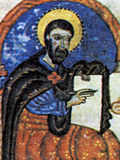Vardan Areveltsi
Vardan Areveltsi | |
|---|---|
| Born | c. 1198 philosopher |
| Known for | Historical Compilation |
Vardan Areveltsi (
Biography
Early life
Vardan was born in Gandzak in 1198. He received his education at a school in Gandzak and at Nor Getik Monastery (later known as
Educational and ecclesiastical activity

Three years later, Vardan traveled to the Cilician Armenia once more, this time participating in the governmental and social affairs of the kingdom. He was a fierce opponent of what he saw as the encroachment of the
In 1252, Vardan returned to Armenia and began organizing an ecumenical council that would convene in
Vardan died in 1271 in Khor Virap, bequeathing a significant literary legacy which encompassed Armenia's political, cultural, religious, and social lives.[3]
Works
Over 120 works attributed to Vardan Areveltsi have been preserved.[3] Among his most significant works is a 66 item collection called Lutsmunk i Surb Grots (better known as Zhghlank, or Chats), which was written at the request of King Het'um I.[5] It is written in the vernacular tongue, making it easily comprehensible and concerns itself with many questions related to the nature of life (nature, the formation of celestial bodies, astronomy, botany and zoology, language, philosophical questions revolving around man, music, etc.).[3] For example, a critical observation Vardan makes in this work is his expression in the belief that, "nothing outside of nature moves nor stops; motion is not solely the movement of one place to another, but an inner transformation which moves from one state to another."[3]
However, Vardan's most important work is his Havakumn Patmutsyun (Historical Compilation). Much like
Vardan also translated many foreign works into Armenian. One of the most significant was Michael the Syrian's Chronicle translation in 1248. Other translated works included conversations and works on philosophy, theology, which were translated from Greek, Latin, and Syriac.[3]
Below is a partial list of his works, many of which, including facsimiles, are currently preserved at the Matenadaran in Yerevan, Armenia.[3]
- Ashqharatsuyts (Geography)
- Lutsmunk i Surb Grots (also known as Zhghlank)
- Havakumn Patmutsyun (Historical Compilation)
- Vark' Zardaretsin (Those who embellished)
References
- ^ Robert W. Thomson. Vardan Arevelc'i // Christian-Muslim Relations. A Bibliographical History. (1200-1350) / Edited by David Thomas and Alex Mallett. — BRILL, 2012. — Vol. 4. — P. 444 "Vardan was known as Arevelc'i ('from the East'), or Mec ('great') to distinguish him from numerous other Vardans."
- ^ The Cambridge History of Iran / Edited by J. A. Boyle. — Cambridge University Press, 1968. — Vol. 5. — p. 42.:"The 7th/13th-century Armenian historian Vardan calls Toghril "leader of the Doger", another Oghuz tribe, who, unlike the Qiniq, did play a significant role in northern Iran"
- ^ Armenian Academy of Sciences, 1985, pp. 312-313. (in Armenian)
- ISBN 0-415-29750-8.
- ISBN 0-8143-3023-1.
- ^ Hacikyan et al. Heritage of Armenian Literature, p. 487.

